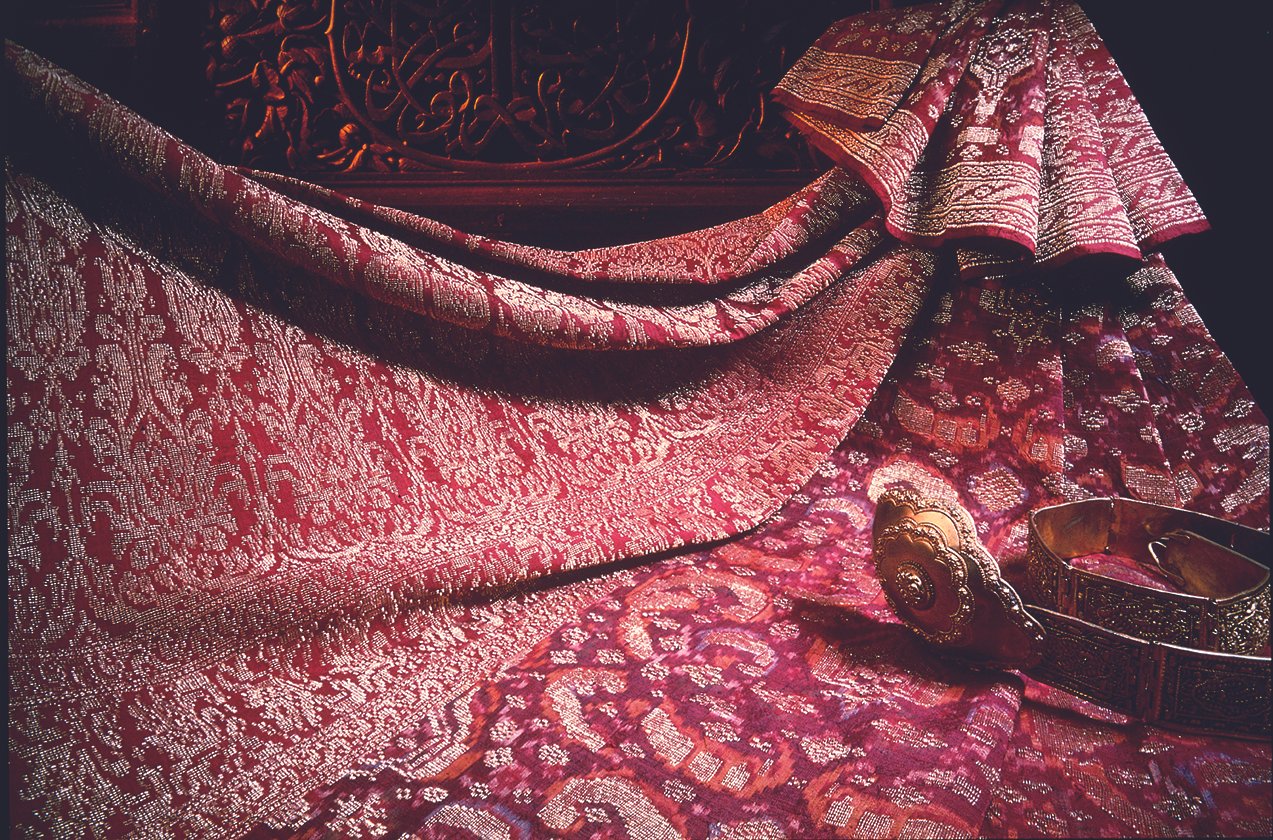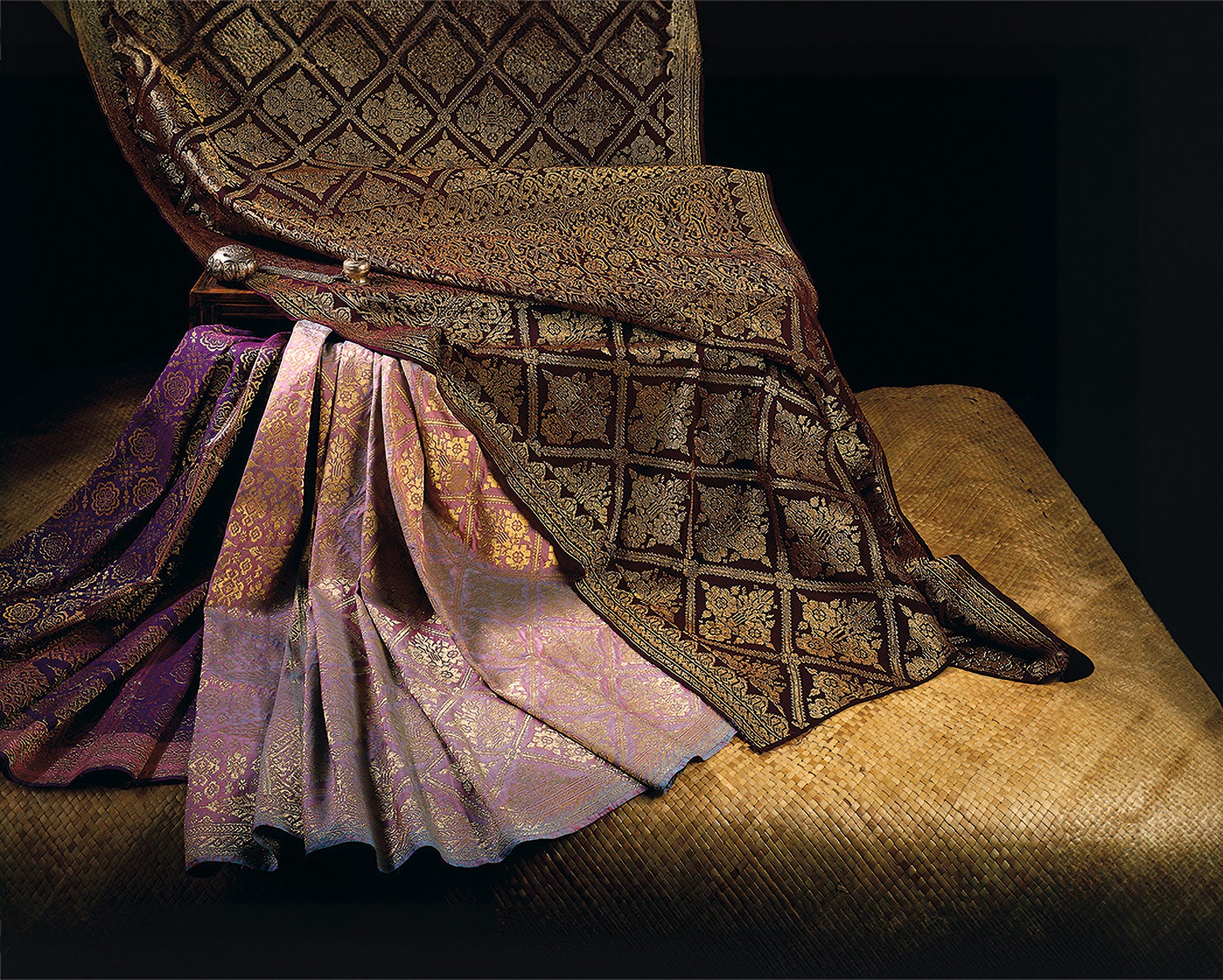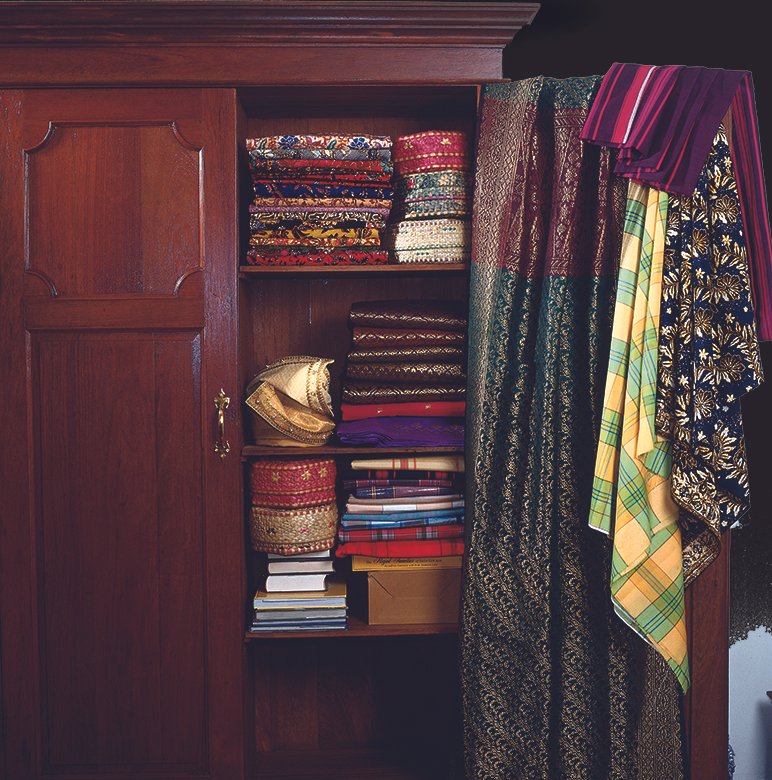Rupa dan Gaya – A Masterwork on Malay Sartorial Splendour
Azah Aziz’s groundbreaking book, Rupa dan Gaya: Busana Melayu, stands as a monumental contribution to the study and appreciation of Malay textiles and traditional attire. First published in 2006 by Universiti Kebangsaan Malaysia, this seminal work transcends mere documentation of fabric and garments to delve into the essence of Malay cultural identity, aesthetics, and the intricate interplay between tradition and modernity. Through meticulous research and evocative storytelling, Azah Aziz has left us an invaluable resource for understanding the cultural and historical significance of Malay textiles and costumes.
In Rupa dan Gaya, Azah sought to document and interpret the sartorial traditions of the Malay people, emphasizing how cloth and clothing serve as a visual and material manifestation of cultural values, social structures, and historical influences. Translated into English as Malay Textiles and Costumes: Form and Style, the book’s title encapsulates its dual focus on the physical appearance (rupa) and the aesthetic essence (gaya) of traditional textiles and garments.
A Comprehensive Exploration of Malay Textiles and Attire
Rupa dan Gaya unfolds as a journey through history, aesthetics, fashion, and cultural anthropology. Azah crafts a detailed narrative that encompasses myriad forms of textiles, resplendent royal raiment, as well as daily clothing and ceremonial dress, exploring their functions, symbolism, and evolution. Her writing strikes a balance between scholarly insight and accessibility, inviting readers of all backgrounds into the captivating world of Malay cultural heritage.
The splendour of Malay textiles and costumes comes to life in Rupa dan Gaya: Busana Melayu. With a deep appreciation for traditional craftsmanship, Azah explores an extensive range of Malay textiles—including songket, limar, ikat, limar songket, batik, and woven textiles as well as embellished textiles such as telepuk, kelingkan and embroidered textiles—shedding light on their historical significance, weaving techniques, and aesthetic intricacies. Central to her study is the recognition of songket, limar, and limar songket as the pinnacle of Malay textile artistry, embodying a heritage of unparalleled refinement. Through her extensive documentation of these diverse textile forms, the book presents a rich and layered portrait of Malay textile heritage, affirming its place as a living tradition that continues to evolve.
Azah’s in-depth study extends to the regional variations of Malay textiles, revealing the distinct weaving traditions across the Malay Peninsula and the broader archipelago. She examines the renowned songket of Terengganu and Kelantan, celebrated for their intricate gold-thread motifs, alongside the rare textiles of Pahang and Riau–Lingga, which bear the influences of Bugis and Minangkabau craftsmanship. She particularly highlights the enduring legacy of kain limar, a weft ikat textile that was once treasured by Malay nobility. Her analysis of batik traces its evolution in the Malay world, distinguishing between block-printed (batik cap), screen printed (batik skrin), and hand-drawn (batik canting) techniques and charting its transformation from an Indonesian import into a uniquely Malay artistic expression. Additionally, she explores the role of royal courts in shaping textile traditions, where artisans were commissioned to create exclusive designs for ceremonial attire, underscoring the deep ties between textiles and Malay courtly culture.
Cloth of batik, and cloth that is woven,
In a wardrobe, with patterned songket attire;
They are alike in beauty, and alike in form,
Now you have it, your heart’s desire.
Among the book’s most compelling aspects is its vivid historical exploration. Azah traces the lineage of Malay textiles and costumes through ancient trade routes that connected the region to India, China, the Middle East, and the Nusantara region. She reveals how these external influences were ingeniously assimilated into Malay culture, while crafting a distinct sartorial identity. Trade brought wide ranging textiles including the much admired double ikat patola from India, which became known as kain cindai in the Malay World. The exquisite cindai was so deeply cherished that its beauty and spiritual virtues were immortalised in classical Malay texts including the Malay Annals and Hikayat Hang Tuah.
Azah’s comprehensive research and vivid descriptions underscores the delicate craftsmanship, symbolic motifs, social values, and cultural narratives embedded in these fabrics, while advocating for their preservation as a vital aspect of Malay identity and artistic heritage. She also delves into how specific patterns, such as the pucuk rebung (bamboo shoot) and awan larat (meandering clouds), are deeply embedded in Malay cosmology, worldview, and aesthetics. Azah also highlights the significance of colour in the making of Malay textiles. More than a hundred colours drawn from nature are given wondrous names that evoke vivid imagery, reflecting the intimate relationship between Malay textile artisans and the natural world. The subtle colours of the Malay imagination also bear poetic names—from kuning langsat (pale yellow of the langsat fruit), to merah delima (soft red of the pomegranate fruit), and hijau pucuk pisang (bright green of young banana leaf shoot), biru nila (indigo blue), merah lemak ketam (bright crimson orange of crab roe), to awan ungu senja (soft purple of the clouds at dusk), and putih bayangan bulan (the pale white shadow of the reflection of the moon).
Exploring the intricate techniques that define traditional Malay textiles, Azah highlights the artistry and skill of their creators. This craftsmanship is not only evident in their woven textiles but also in the delicate art of kelingkan embroidery, where metallic threads create shimmering motifs—another testament to the refinement of Malay artisans. Techniques such as gerus, which involves the burnishing of fabric to create a glossy finish, and telepuk, where gold leaf is applied to fabric to yield gilded patterns, further illustrate the ingenuity embedded in Malay textile traditions.
In Rupa dan Gaya, Azah Aziz also emphasizes the importance of headdress and accessories in completing Malay attire. She explores how tengkolok (folded headgear) and other traditional headdresses signify status, regional identity, and ceremonial importance. Accessories such as kerongsang (brooches), pending (belt buckles), kalong (necklaces), cucuk sanggul (hairpins) and gelang (bangles) are not simply decorative but serve as expressions of refinement and cultural symbolism. Through these adornments, she reveals how every element of Malay attire comes together to form a harmonious and meaningful whole.
The book also investigates how clothing mirrors gender roles and social hierarchies within Malay culture. Azah highlights the differences between male and female garments, such as the baju Melayu for men and the baju kurung or kebaya for women. She discusses how these outfits are designed to emphasise modesty, elegance, and practicality. She also offers insights into the variations in clothing among different social classes and regions, revealing the diversity within Malay sartorial traditions.
A remarkable feature of the book is Azah’s incorporation of pantun (traditional Malay quatrains) and excerpts from hikayat (classical Malay epics). These literary elements infuse her exploration of textiles and garments with life, highlighting their deeper cultural and symbolic significance. The pantun, with its lyrical elegance, often acts as a link between the tangible beauty of Malay textiles and attire and the intangible values they embody, such as humility, grace, and community bonds. Similarly, the hikayat passages provide historical and mythological contexts, situating Malay textiles within a broader narrative of identity and aesthetics. By weaving poetry, traditions, and cultural beliefs into her discussion of Malay costumes and textiles, Azah presents a comprehensive understanding of Malay culture, where poetry, art, and daily life traditions are inextricably intertwined.
Threads of Continuity
While Rupa dan Gaya celebrates the richness of traditional textiles and attire, it also addresses the challenges of preserving these practices in a rapidly modernizing world. Azah articulates the importance of intergenerational transmission, urging younger generations to appreciate and uphold their cultural heritage. She highlights contemporary efforts to revive traditional crafts, such as handwoven textiles and traditional tailoring, as a means of sustaining the legacy of Malay attire.
What sets Rupa dan Gaya apart from other works on traditional textiles and attire is Azah’s deeply personal connection to the subject matter. Her narrative brims with anecdotes and reflections, drawing readers into her experience of Malay culture. Whether recounting the process of sourcing antique textiles and garments or sharing memories of cultural ceremonies, Azah’s voice exudes authenticity and passion. This personal touch makes the book not only an academic resource but also a heartfelt ode to the beauty and resilience of Malay traditions.
Costumes of the gamelan dancers are among the most beautiful.
Since its publication, Rupa dan Gaya has profoundly influenced cultural studies and heritage preservation in Malaysia. Its scholarly rigour, paired with stunning visuals, has captivated readers and inspired a resurgence of interest in traditional Malay textiles and clothing. Designers, educators, and cultural advocates have drawn from its insights to reimagine Malay sartorial heritage in contemporary contexts.
Rupa dan Gaya has contributed to the global recognition of Malay culture. By documenting and interpreting Malay textiles and attire in a comprehensive and accessible manner, Azah has positioned it as a vital thread in the global fabric of cultural heritage. The book serves as an indispensable reference for international scholars, museum curators, and textile enthusiasts worldwide.
Drought of dew brought by a sun shower,
Out in the fields we venture to dry the padi;
My Lord, like fire-flies in the garden you glimmer,
Radiant like the sun in all its morning glory
Cik Dayang shielded in a kelubung dared,
Alone to the market she did wander;
Snapped threads may still be mended,
But splintered coals stay broken forever.
If a strand of thread one day should be,
Transformed to cloth in the days thereafter;
Indeed, from day to day I think of thee,
Not for a moment lend thought to another.
A Lasting Legacy
Azah Aziz’s legacy extends far beyond the pages of Rupa dan Gaya. Her work has ignited a commitment to cultural preservation among many individuals. As a pioneer in documenting and celebrating Malay traditions, she has paved the way for future generations to carry forward her mission. Her emphasis on cultural continuity and the importance of appreciating one’s roots resonates deeply in an era of globalization and cultural homogenization.
Rupa dan Gaya: Busana Melayu is not merely a book; it is a treasure trove that captures the essence of Malay identity and heritage. Through her vibrant prose and incisive research, Azah Aziz has opened a portal into the intricate world of Malay textiles and attire, shedding light on its historical, social, and aesthetic dimensions. Her work is a powerful testament to the richness of Malay culture and the enduring significance of preserving our shared heritage. For those who seek to grasp the soul of Malay identity, Rupa dan Gaya is an inspiring guide, weaving together threads of history, artistry, and community with unparalleled elegance.
RESPLENDENT RAIMENT OF CIK SITI WAN KEMBANG
Cik Siti Wan Kembang reigns Queen of a blessed land:
Tanah Serendah
Sekebun Bunga
Cerang Tegayung
A lowland clearing
With flower gardens
Lit by dappled sunlight
Filtered through Tegayong trees
Cik Siti Wan Kembang with kemban worn high
Silk limar shoulder cloth clings to her supple skin
Songket in kesumba red with scattered flowers
Tied with elegant fern-like folds
Its ends falling to an oblique point
Almond shaped buckle of pure fine gold
Studded with rubies and gems
A winged breastplate pendant upon her chest
Anklets of dragons in combat
A sparkling tiara of gold and precious jewels
On one side of her coiffure gold floret chains drape
With an orchid ornamenting the ear
The ring in turn has nine coloured gemstones
With the jewels twinkling on her fingers
Garam sebubu, a large sparkling solitare diamond
In her right hand is
The keris of state
Such is her priceless beauty beyond compare
Stirring melancholic longing of all in sight
Kalau tuan pergi ke bendang,
Jangan petik buah rembia;
Tuan umpama bulan mengambang,
Cahaya meliput serata dunia.
If My Lord to the rice fields you do go,
The palm fruit do refrain from picking;
Like the moon, My Lord does brilliantly glow,
Across the globe ever radiantly shining.
From silk is thread made,
From thread is cloth made,
Patterns of exceptional beauty,
Scattered with eight petalled rosettes,
Swirling waters and shifting stars.
Patterns of jong sarat, teluk berantai,
Bamboo shoots, a grand sight to see,
Songket cloth with lustrous designs,
From nature’s wide universe are,
These wondrous inspirations drawn.

Limar songket of exquisite design,
Garments for kings in days of old;
Like the moon you so radiantly shine,
A light that pierces deep into my soul.









